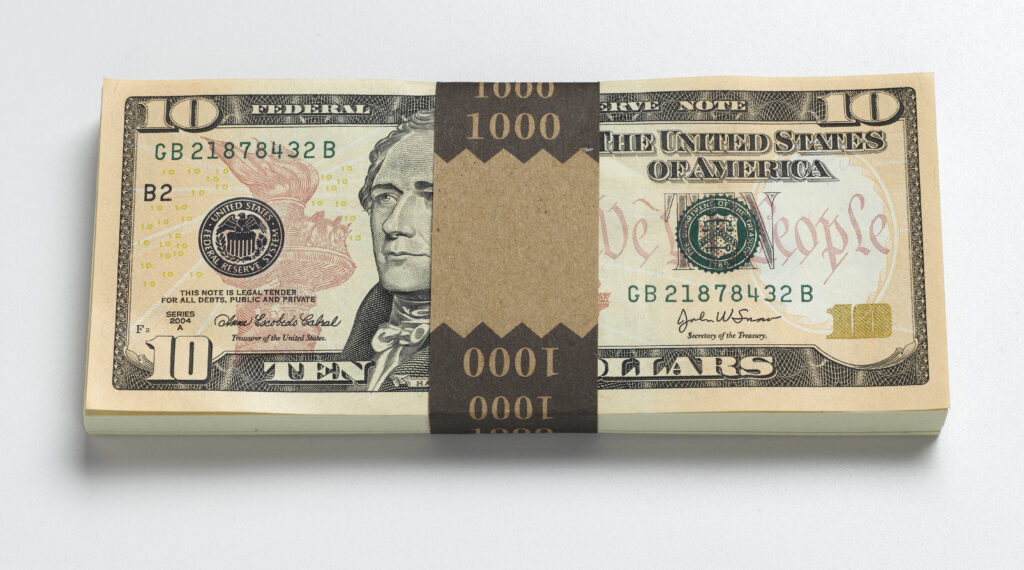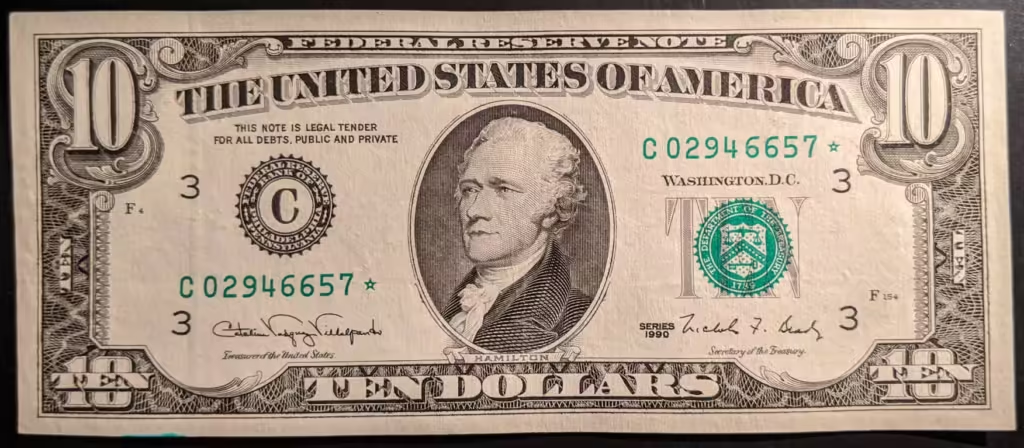
Stack of one hundred US ten dollar bills, elevated view
Who is on the Ten Dollar Bill?
Who is on the Ten Dollar Bill: When you pull out a ten-dollar bill, do you ever wonder, “Who is on the ten dollar bill?” Well, the person on the bill is none other than Alexander Hamilton, one of the Founding Fathers of the United States. While you might already be familiar with some of the faces on U.S. currency, like George Washington on the one-dollar bill or Abraham Lincoln on the five-dollar bill, Hamilton’s presence on the ten-dollar bill is a bit different. Unlike Washington or Lincoln, Hamilton was not a president, but his contributions to the country are immense. Let’s take a look at who Alexander Hamilton was, why he’s on the ten-dollar bill, and what his legacy means for Americans today.
Who Was Alexander Hamilton? Who is on the Ten Dollar Bill
Who is on the Ten Dollar Bill: To understand why Hamilton is on the ten-dollar bill, we need to first understand who he was. Born in 1755 on the Caribbean island of Nevis, Hamilton had a rough childhood. His father abandoned him, and his mother passed away when he was young, leaving him an orphan. Despite these hardships, Hamilton was a bright and ambitious young man. He eventually moved to New York, where he attended King’s College (now Columbia University). It was during his time in New York that Hamilton became involved in the American Revolution.
Who is on the Ten Dollar Bill: Hamilton served as an aide to General George Washington during the war, quickly proving himself as a capable and talented individual. After the war, Hamilton’s talents in law, economics, and politics helped him become one of the most important figures in the early United States government. He went on to serve as the first Secretary of the Treasury under President Washington, where he played a key role in shaping the country’s financial system.

Why Was Alexander Hamilton Chosen for the Ten Dollar Bill?
Who is on the Ten Dollar Bill: So, why is Alexander Hamilton on the ten-dollar bill and not one of the more famous presidents? Well, Hamilton made significant contributions to America’s financial systems, and it’s these accomplishments that earned him a spot on U.S. currency.
When Hamilton was appointed as Secretary of the Treasury in 1789, the United States was facing serious financial problems. The country had just emerged from the Revolutionary War, and the federal government was in debt. Hamilton’s vision and work in creating a stable economy helped transform the U.S. into a financially secure nation. He designed a plan to deal with the national debt, established the nation’s first central bank, and helped create a stable currency for the country.
Who is on the Ten Dollar Bill: One of Hamilton’s most lasting contributions was the creation of the Bank of the United States. This institution laid the groundwork for the modern financial system, allowing the U.S. to raise money, regulate credit, and ensure the economy could grow. His ideas helped set the U.S. apart from other nations and laid the foundation for the country’s future financial policies.
In fact, Hamilton’s influence on the economy was so significant that many people at the time saw him as the “father of American finance.” This is why his face was chosen to appear on the ten-dollar bill in 1929. His work in establishing the country’s economic system is still important today, which is why we continue to honor his legacy.
The Legacy of Alexander Hamilton: More Than Just a Financial Genius
Who is on the Ten Dollar Bill: While Hamilton’s role as a financial genius is well-known, his legacy goes far beyond just economics. He was a strong believer in a strong central government, which set him apart from other figures of his time. His ideas helped form the structure of the U.S. Constitution, and he was one of the key authors of the Federalist Papers, a series of essays that argued for the ratification of the U.S. Constitution. Without Hamilton’s influence, the U.S. might not have developed into the nation it is today.
Hamilton also played a role in shaping the country’s political landscape. While many of the Founding Fathers, like Thomas Jefferson, were advocates for a limited federal government, Hamilton believed that a strong, centralized government was essential to the country’s success. This disagreement between Hamilton and Jefferson led to the development of the first political parties in the United States.
Who is on the Ten Dollar Bill: His beliefs and ideas about government were controversial, but they also provided the foundation for many of the policies and institutions that we take for granted today, such as the banking system, the Constitution, and the federal government’s role in managing the economy. His life and ideas were so influential that they continue to be discussed in political circles and history classes today.

The Design of the Ten Dollar Bill: A Look at Hamilton’s Portrait
Who is on the Ten Dollar Bill: The design of the ten-dollar bill has undergone several changes since it was first issued. The portrait of Alexander Hamilton has remained a constant feature, but other aspects of the bill have been updated. The current design was first introduced in 1929, and it features Hamilton’s face prominently on the front of the bill.
The back of the bill depicts the U.S. Treasury building, which is a symbol of the financial system that Hamilton helped create. This design choice further emphasizes Hamilton’s importance in shaping the country’s economy.
Who is on the Ten Dollar Bill: The bill also features several security features that help prevent counterfeiting, including a security thread, watermark, and microprinting. While the design of the ten-dollar bill has evolved over time, Hamilton’s portrait continues to serve as a reminder of his lasting impact on the nation’s finances.
Fun Facts About Alexander Hamilton and the Ten Dollar Bill
Here are some fun and interesting facts about Alexander Hamilton and the ten-dollar bill: Who is on the Ten Dollar Bill
- Hamilton wasn’t a president. While many U.S. bills feature former presidents, Hamilton was never the president. He is, however, one of the most important figures in U.S. history.
- Hamilton is considered the “father” of American finance. His work in creating the national bank and establishing a stable currency helped set the foundation for the country’s financial system.
- The ten-dollar bill has featured Hamilton since 1929. Although there have been discussions about changing the person featured on the ten-dollar bill, Hamilton’s image has remained on the bill for nearly a century.
- Alexander Hamilton’s life was full of drama. From his rise from poverty to his deadly duel with Aaron Burr, Hamilton’s life was filled with intrigue and conflict. His story is so captivating that it was turned into a Broadway musical called Hamilton.
- The ten-dollar bill is widely circulated. The ten-dollar bill is one of the most commonly used denominations in the U.S., making Hamilton’s portrait one of the most frequently seen images in American currency.
How Alexander Hamilton Helped Shape America: Who is on the Ten Dollar Bill
Who is on the Ten Dollar Bill: As we’ve learned, Hamilton was instrumental in shaping the United States. His work in finance, government, and law helped create the nation’s political and economic systems. His ability to solve complex problems, like the national debt, made him a key figure in early American history.
Hamilton’s belief in a strong central government also helped shape the way the United States is governed today. His vision for a nation with a powerful federal government set the stage for the policies that continue to guide the country. Without Hamilton, the United States might not have been able to compete with other nations in the early years of its existence.
Hamilton’s Impact on the U.S. Constitution and Political Parties: Who is on the Ten Dollar Bill
Alexander Hamilton was also deeply involved in the creation of the U.S. Constitution. He was a strong advocate for ratifying the document and helped write the Federalist Papers, which argued for a strong federal government. His work in drafting the Constitution was critical in ensuring that the United States would have a unified system of government.
Hamilton’s views were often at odds with those of Thomas Jefferson, which led to the formation of the country’s first political parties. While Jefferson believed in a more limited government, Hamilton wanted a stronger, more centralized government. These disagreements helped shape the early political landscape of the United States and continue to influence American politics today.
Conclusion: Who is on the Ten Dollar Bill
In conclusion, Alexander Hamilton’s contributions to the United States are undeniable, and his place on the ten-dollar bill serves as a reminder of his impact on the country’s financial, political, and legal systems. From his work as the first Secretary of the Treasury to his influence on the creation of the U.S. Constitution, Hamilton’s legacy is woven into the fabric of the nation.
Though Hamilton was never a president, his ideas helped create the country that we live in today. His portrait on the ten-dollar bill is a fitting tribute to a man whose vision and work helped lay the groundwork for the financial and political systems that shape the United States. Today, Alexander Hamilton remains an important figure in American history, and his story continues to inspire people all over the world.
